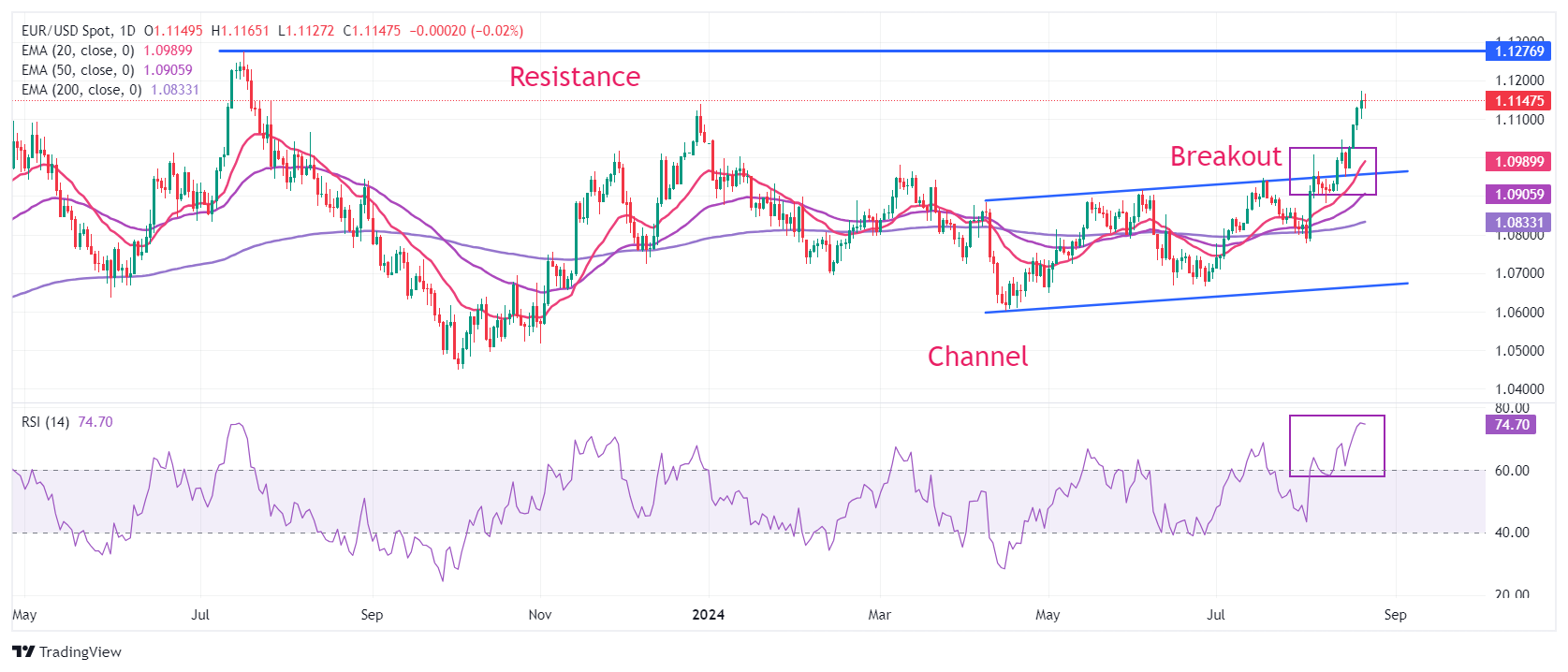EUR/USD eases on weak German flash PMI, soft Eurozone Q2 wage growth

- EUR/USD falls slightly as upbeat Eurozone’s flash PMI fails to offset soft Q2 Negotiated Wage Rates.
- The German PMI suggested that activity contracted at a faster pace in August.
- The US Dollar remains in a bearish trajectory with Fed Powell’s speech in focus.
EUR/USD eases to 1.1130 in Thursday’s early North American session from a fresh year-to-date high of 1.1175 posted on Wednesday. The major currency pair trades slightly lower to near 1.1130 as the US Dollar (USD) edges higher but remains close to a fresh 2024 low. The US Dollar Index (DXY), which tracks the Greenback’s value against six major currencies, trades close to 101.00. The outlook of the US Dollar remains bearish as the Federal Reserve (Fed) appears to be on track to cut interest rates in September.
This would be the first dovish interest rate decision by the Fed in more than four years. The US central bank has maintained a restrictive monetary policy stance since March 2022 to bring down inflation.
Market speculation for Fed interest rate cuts has strengthened as the “vast majority” of Fed officials see policy-easing in September as appropriate, given that inflationary pressures continue to ease further, according to the Federal Open Market Committee (FOMC) minutes of July 30-31 policy meeting. The FOMC minutes also showed that some policymakers were ready to reduce interest rates already back in July.
For more cues on the interest rate path, investors will focus on Fed Chair Jerome Powell’s speech on Friday at the Jackson Hole (JH) Symposium, which will begin at 14:00 GMT. Investors will pay attention to clues about the size of interest rate cuts in September and by how much the Fed could reduce them this year.
In Thursday’s session, investors will keenly focus on the US flash S&P Global PMI data for August, which will be published at 13:45 GMT. The preliminary PMI report is expected to show that the Composite PMI fell to 53.5 from 54.3 in July.
Daily digest market movers: EUR/USD drops as German PMI declines sharply in August
- EUR/USD falls slightly as German flash HCOB Composite PMI unexpectedly contracted at a faster-than-expected pace in August, and soft Q2 Eurozone Negotiated Wage Rates weigh on the Euro (EUR).
- The flash German PMI report showed that activities in the manufacturing sector declined further to 42.1. In the service sector, activities expanded data at a slower-than-projected pace to 51.4.
- On the contrary, Eurozone Composite PMI unexpectedly rose to 51.2, beating economists’ expectations. The report showed that the strong expansion came from robust growth in the service sector’s activity. The Service PMI expanded strongly to 53.3 from the estimates and the prior release of 51.9. On the contrary, the Manufacturing PMI declined further to 45.6, lower than the 45.8 expected.
- Commenting on the flash PMI data, Dr. Cyrus de la Rubia, Chief Economist at Hamburg Commercial Bank, said: “The boost largely comes from a surge in services activity in France, with the Business Activity Index jumping by almost five points, likely linked to the buzz surrounding the Olympic Games in Paris. It’s doubtful this momentum will carry over into the coming months, however. Meanwhile, the overall pace of growth in the services sector has slowed down in Germany, and the Eurozone’s manufacturing sector remains in rapid decline.”
- The slowdown in the German economy signaled by the PMI data is unlikely to weigh on market speculation about the European Central Bank (ECB) interest-rate outlook. However, slower wage growth momentum would strengthen them further. Negotiated Wage Rates rose at a slower pace of 3.55% from 4.69% seen in the first quarter this year, upwardly revised from 4.74%.
- Markets broadly expect the ECB to cut its key borrowing rates one more time in the last quarter of this year, given that price pressures are anticipated to return to the bank’s target of 2% next year.
Technical Analysis: EUR/USD clings to gains above 1.1100
EUR/USD trades inside Wednesday’s trading range, with investors focusing on the Fed Powell’s speech at the JH Symposium on Friday. The major currency pair is expected to continue its four-day winning streak as its outlook has strengthened, given that it is trading close to a year-to-date high near 1.1175.
Earlier, the shared currency pair strengthened after a breakout of a channel formation on a daily time frame. All short-to-long-term Exponential Moving Averages (EMAs) are sloping higher, suggesting a strong uptrend.
The 14-day Relative Strength Index (RSI) oscillates in the bullish range of 60.00-80.00, suggesting a strong upside momentum. Still, chances of a corrective pullback increase as the momentum indicator is in overbought territory.
After a decisive break above the December 28, 2023, high at 1.1140, Euro bulls aim to recapture round-level resistance of 1.1200. On the downside, the round-level figure of 1.1100 will act as a major support zone.
